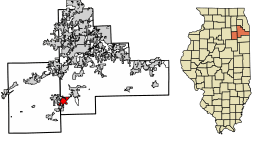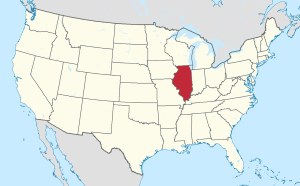Braidwood, Illinois facts for kids
Quick facts for kids
Braidwood
|
|
|---|---|

Location of Braidwood in Will County, Illinois.
|
|

Location of Illinois in the United States
|
|
| Country | United States |
| State | Illinois |
| County | Will |
| Area | |
| • Total | 5.47 sq mi (14.17 km2) |
| • Land | 5.30 sq mi (13.72 km2) |
| • Water | 0.18 sq mi (0.46 km2) |
| Elevation | 568 ft (173 m) |
| Population
(2020)
|
|
| • Total | 6,194 |
| • Density | 1,169.56/sq mi (451.61/km2) |
| Time zone | UTC-6 (CST) |
| • Summer (DST) | UTC-5 (CDT) |
| ZIP code |
60408
|
| Area code(s) | 815/779 |
| FIPS code | 17-07770 |
| GNIS feature ID | 2394237 |
| Wikimedia Commons | Braidwood, Illinois |
Braidwood is a city in Will County, Illinois, United States. It's about 53 miles (85 km) southwest of Chicago. The city is also 18 miles (29 km) south of Joliet. In 2020, about 6,194 people lived there.
The Braidwood Nuclear Generating Station is a large power plant nearby. It creates a lot of electricity for the Chicago area. This plant is a major employer in the region.
Students in Braidwood attend schools in the Reed-Custer Community Unit School District 255. This district also serves students from Custer Park, Essex, and Godley. There are three schools: Reed-Custer Elementary (PreK-5), Reed-Custer Middle School (6-8), and Reed-Custer High School (9-12).
Contents
Exploring Braidwood's Location
Braidwood is located at coordinates 41.271982°N, -88.218221°W.
How Big is Braidwood?
According to the 2010 census, Braidwood covers about 4.76 square miles (12.34 square km). Most of this area, about 4.58 square miles (11.86 square km), is land. The rest, about 0.18 square miles (0.48 square km), is water.
Main Roads in Braidwood
Several important highways pass through or near Braidwood. These roads help people travel to and from the city.
|
Interstate Highways
|
US Highways |
Illinois Highways
|
Who Lives in Braidwood?
| Historical population | |||
|---|---|---|---|
| Census | Pop. | %± | |
| 1880 | 5,524 | — | |
| 1890 | 4,641 | −16.0% | |
| 1900 | 3,279 | −29.3% | |
| 1910 | 1,958 | −40.3% | |
| 1920 | 1,297 | −33.8% | |
| 1930 | 1,161 | −10.5% | |
| 1940 | 1,354 | 16.6% | |
| 1950 | 1,485 | 9.7% | |
| 1960 | 1,944 | 30.9% | |
| 1970 | 2,323 | 19.5% | |
| 1980 | 3,429 | 47.6% | |
| 1990 | 3,584 | 4.5% | |
| 2000 | 5,203 | 45.2% | |
| 2010 | 6,191 | 19.0% | |
| 2020 | 6,194 | 0.0% | |
| U.S. Decennial Census | |||
In 2000, Braidwood had 5,203 people living in 1,843 households. About 1,422 of these were families. The city had about 1,124 people per square mile (434 per square km).
Community Life in Braidwood
Many households in Braidwood had children under 18 living with them (39.8%). Most households were married couples (62.3%). About 18.5% of households were single individuals.
The population's age was spread out. About 29.5% were under 18. The median age was 34 years. This means half the people were younger than 34, and half were older.
Braidwood's Mining History
Braidwood began in 1864 when a farmer found coal while digging for water. There was a lot of coal, and Chicago needed it. So, companies quickly bought land and started mining.
How Braidwood Became a City
A mining boomtown quickly grew. A post office opened in 1867. The community was first called Keeversville. In 1872, James Braidwood was hired to oversee the first deep mine shaft. More mines followed. On March 4, 1873, the city was officially formed and named after him.
Life in a Coal Mining Town
Life in Braidwood revolved around the coal mines. When coal demand was high, the town did well. When it was low, especially in summer, many miners lost their jobs. There were often disagreements between mine owners and workers about pay and conditions.
The Diamond Mine Disaster
A sad event happened on February 16, 1883. The Diamond Mine in Braidwood suddenly flooded. This tragic accident caused the deaths of 73 miners. You can learn more about it at 1883 Diamond Mine Disaster.
Diverse Community
Braidwood's early miners came from different places. Many were Americans or immigrants from northern Europe. Later, African Americans arrived from West Virginia. Immigrants from eastern and southern Europe also came to live and work in Braidwood. This mix of people created a rich cultural community.
Famous People from Braidwood
Many interesting people have connections to Braidwood:
- Kay Cannon: A talented writer known for shows like 30 Rock. She was nominated for an Emmy award.
- Anton Cermak: An immigrant from Bohemia who became the 34th mayor of Chicago. He worked as a miner in Braidwood when he was younger.
- Brian Dubois: A pitcher who played for the Detroit Tigers. He played in state championships with Reed-Custer High School.
- Artie Matthews: A songwriter, pianist, and ragtime composer. He was born in Braidwood in 1888.
- John Mitchell: An important early president of the United Mine Workers union. He was born in Braidwood in 1870 and worked in the local mines as a child.
- Les Norman: An outfielder for the Kansas City Royals. He also played in state championships with Reed-Custer High School.
- Doug Pinnick: A songwriter, bassist, and singer for the rock band King's X. He was born and grew up in Braidwood.
See also
 In Spanish: Braidwood (Illinois) para niños
In Spanish: Braidwood (Illinois) para niños

